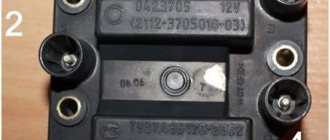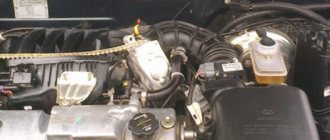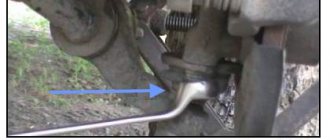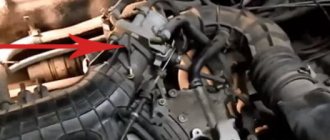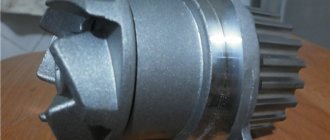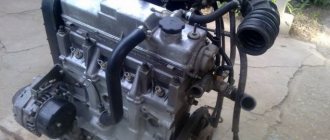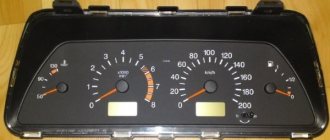Symptoms of overheating
The temperature arrow tends to the red zone - soon overheating
A fully warmed-up engine has an operating temperature in the range from 92 to 102 ° C , exceeding which can cause big trouble. Its condition is monitored by a sensor that turns on the cooling fan. The fan turns on on the stock firmware at a temperature of 102 °C .
The first symptom of engine overheating is the reading on the instrument panel; in this case, its needle approaches the red indicator.
Steam from under the hood
Steam from under the hood
If steam appears from under the hood, this indicates an increased temperature of the coolant of the power unit.
Strongly heated antifreeze splashes out of the expansion tank cap and hits the hot engine elements, which is why steam is formed. In this case, wet traces will form under the car, which have a characteristic smell of coolant.
Squeezes antifreeze out of the expansion tank
If these symptoms appear, you should immediately stop using the car and start looking for symptoms of overheating , otherwise the engine may fail, which will lead to an expensive overhaul.
Sensor check
Your VAZ 2114 engine overheats, or other signs of DTOZh failure appear. This suggests that you should check this element first.
There are two verification methods, each of which we will introduce you to.
First method
Removal
- Start the car, look at the dashboard. The gauge is at maximum, but the engine is still cold. Disconnect the contacts from the meter. If after this the arrow falls as far as possible, this indicates the need to replace the coolant temperature sensor on the VAZ 2114.
- If the arrow remains at the top, at the maximum level, take a closer look at the DTOZh contacts. Often they simply short circuit to the vehicle's ground.
- The engine may heat up normally, evenly, but the gauge needle jumps in different directions. Most likely the fuses have failed.
- If the fuses are good, close the contact to ground. If the arrow immediately jumps up, then the temperature sensor has failed.
Method two
- Take a multimeter and turn it on in ohmmeter mode.
- Arm yourself with a thermometer with notches over 100 degrees Celsius.
- Prepare heat-resistant containers that will not deform due to hot coolant.
- Connect the probes of the device to the sensor terminal and the housing.
- Having connected the DTOZH, place it in a container with coolant and begin heating.
- Monitor the ohmmeter and thermometer readings at the same time.
The table shows readings that correspond to a working, serviceable sensor. Using this method, you can check the condition of the new sensor before installing it in place of the old one.
| Temperature, C | Resistance, Ohm |
| 30 | 1350-1880 |
| 50 | 585-820 |
| 70 | 280-390 |
| 90 | 155-196 |
| 110 | 87-109 |
What to do if your car overheats in a traffic jam
When driving a car for a long time in a lower gear, the engine operates with increased power, which in itself leads to overheating. Add to this the lack of oncoming air flow necessary to cool the radiator. What to do?
The main thing is not to panic. Short-term overheating is not terrible, but if you see that the car is not cooling down, it’s time to act.
Important - do not turn off the engine unless absolutely necessary. Exactly - without extreme. A stalled, overheated engine is an almost 100% guarantee of repair. It will take quite a long time to describe what is happening in the engine in this case (rotating the liners together with the crankshaft, when the engine is subsequently started - the least of the possible troubles), just take it on faith.
Important - do not think about pouring water on the engine or pouring cold water into the radiator. The result is the same - repair. Moreover, you can try so hard that you cannot do without replacing the block and cylinder head. Another “beauty” of cold water is microcracks inside the block. Finding and eliminating will be very, very difficult, if not impossible. The car has overheated - try to pull over to the side of the road. If it doesn’t work out, don’t panic and don’t pay attention to those around you – it’s important for you to save the engine. Stop at idle, turn the heater on full, and wait. If after 5-10 minutes the situation does not improve, turn off the engine.
It’s a good idea to open the hood; the main thing in a panic is not to forget to set the car’s parking brake. The only reason to turn off the engine right away is clouds of steam coming from under the hood. Most likely, the cooling pipe has burst, and further operation of the engine will only worsen the situation.
This is what it looks like, engine overheating, if you look closely. Now you know why the engine gets hot and how to deal with it. Author: Igor
With the arrival of warmer weather, many drivers are faced with poor performance of the VAZ cooling system when the VAZ 2114 engine gets very hot. There are quite a few reasons why the engine overheats. You need to understand the reasons and find out ways to combat overheating.
Return to contents.
Communities › VAZ: Repair and Modification › Forum › VAZ 2114 heats up quickly
people help with advice! My car heats up quickly, the fan turns on very often, which really annoys me! (What could be the problem, I blame the thermostat myself! I changed the pump, but I really didn’t change the antifreeze.
The thermos is stuck in a small circle, or a slightly open large circle, rather the latter, because the propeller is cooling down.
The thermos is stuck in a small circle, or a slightly open large circle, rather the latter, because the propeller is cooling down.
does that mean the thermostat needs to be changed?)
I changed it back in December, look at my bulletin board, install this one, you won’t regret it =)
The thermos is stuck in a small circle, or a slightly open large circle, rather the latter, because the propeller is cooling down.
I have a similar case, but the pipes work as expected. and are there DTOZH with different temperature values? Yes, I changed the radiator and pump last year, there is no flow from the return to the tank, but the hose is hot and can it be blown into the radiator?
It’s just that you even stand at a traffic light and the Carlson starts up!
When my thermostat died in winter, the car, on the contrary, did not heat up. Changing the thermostat costs about 250 rubles. The thermostat itself is 300-350 rubles. business for 10 minutes. 1000 rubles in your pocket and in the service

